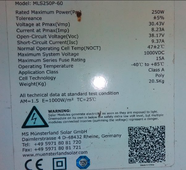Dumb question.
There's a lot of info on how to calculate wiring sizes, controllers, etc based on the 2 different voltages, but I can't find info about what real world numbers will be on a sunny day. Is there a way you think about them to keep the differences in your head.
Is this how I should think about the differences?
Vmp - 30v
-is real voltage output when everything is connected/ closed curcuit
- lower volts used for wire calcs = bigger guage
VOC - 38v
-is max voltage when open, as in not in a closed circuit or producing power. Just measuring leads.
- higher volts + cold co = used for hardware choices/ calcs
So when I received my used panels I checked and was getting 36 point something volts (voltage is 30v, Voc 38, 250w, 60 cell solar farm panels. I had them leaning up against something on the ground. I now have them mounted and at the correct angle. I have the system hooked up to my charge controller in 3s to get 114v max plus cold Co. I'm not reading more than 90 volts even at the combiner box over the past few days since I finished everything. Why was I seeing 36 when checking the individualy from the their mc4 connectors vs being hooked up and lower voltage? I'm assuming they will run at 30v unless it gets cold out and drives the voltage up with cold co.
There's a lot of info on how to calculate wiring sizes, controllers, etc based on the 2 different voltages, but I can't find info about what real world numbers will be on a sunny day. Is there a way you think about them to keep the differences in your head.
Is this how I should think about the differences?
Vmp - 30v
-is real voltage output when everything is connected/ closed curcuit
- lower volts used for wire calcs = bigger guage
VOC - 38v
-is max voltage when open, as in not in a closed circuit or producing power. Just measuring leads.
- higher volts + cold co = used for hardware choices/ calcs
So when I received my used panels I checked and was getting 36 point something volts (voltage is 30v, Voc 38, 250w, 60 cell solar farm panels. I had them leaning up against something on the ground. I now have them mounted and at the correct angle. I have the system hooked up to my charge controller in 3s to get 114v max plus cold Co. I'm not reading more than 90 volts even at the combiner box over the past few days since I finished everything. Why was I seeing 36 when checking the individualy from the their mc4 connectors vs being hooked up and lower voltage? I'm assuming they will run at 30v unless it gets cold out and drives the voltage up with cold co.
Last edited:



